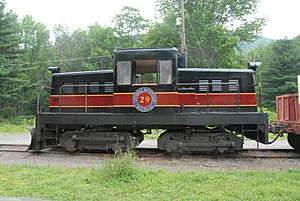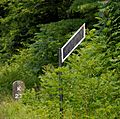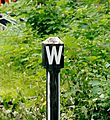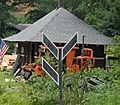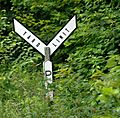Catskill Mountain Railroad facts for kids
Quick facts for kids Catskill Mountain Railroad |
|
|---|---|
| Terminus | Kingston-Stony Hollow, New York |
| Commercial operations | |
| Built by | Ulster & Delaware Railroad |
| Original gauge | 4 ft 8 1⁄2 in (1,435 mm) |
| Preserved operations | |
| Owned by | Ulster County, New York |
| Operated by | Catskill Mountain Railroad |
| Reporting mark | CMRR |
| Preserved gauge | 4 ft 8 1⁄2 in (1,435 mm) |
| Commercial history | |
| Closed | 1976 |
| Preservation history | |
| August 9, 1982 | CMRR begins operations |
| Headquarters | Kingston, New York |
| Website | |
| catskillmountainrailroad.com/ | |
The Catskill Mountain Railroad (CMRR) is a special tourist railroad in Kingston, New York. It started running trains in 1982. The railroad uses a 4.7-mile part of an old train line. This line goes from Kingston to Stony Hollow, New York.
The tracks are owned by Ulster County, New York. The county bought them in 1979. The Catskill Mountain Railroad has permission to use these tracks until the end of 2028.
Contents
- What the Railroad Does Now
- Future Plans for the Railroad
- Being Environmentally Friendly
- Possible Long-Term Expansions
- How Many People Ride the Train
- History of the Catskill Mountain Railroad
- How the Railroad Has Operated
- Other Parts of the Line
- Train Equipment
- Ashokan Rail Trail Conversion History
- Photo gallery
- See also
What the Railroad Does Now
The CMRR runs trains on a 4.7-mile section of track. This track was once part of the Ulster and Delaware Railroad. The trains go from Kingston to Stony Hollow, New York.
The Kingston station is near the Kingston Plaza Shopping Center. The line ends close to the Route 28A crossing in Stony Hollow. You can easily walk to the station from the Kingston Stockade District. You can also walk from Midtown Kingston along the Kingston Midtown Linear Park.
The CMRR offers many different train rides. The season starts in spring with the Easter Bunny Express. Trains run regularly until Christmas. In summer, you can ride the Catskill Mountain Flyer. There are also the Twilight Limited and Ice Cream Sundays Train. In the fall, they have Fall Foliage and Pumpkin Express trains. From Thanksgiving to Christmas, they run Polar Express trains.
The trains are pulled by a special engine called Alco RS-1 401. The trains have six flatcars that were changed to carry passengers. There is also a refurbished caboose (number 675). They also use five passenger coaches from the Long Island Rail Road.
Ulster County is looking at a plan to make the train line longer. The railroad wants to extend the line to Basin Road. This would allow them to build a new station and event center there. This extension would also help people get to the Ashokan Rail Trail. In May 2024, the county agreed to review this plan.
The CMRR has also suggested a "Rail-with-Trail" idea. This means having both train tracks and a walking/biking trail next to each other. They presented this idea to the U&D Corridor Committee in October 2024. A report from 2024 showed that having both a rail and a trail is possible. It would cost about 25% more than just building a trail.
Future Plans for the Railroad
Basin Road Station Expansion
As of 2024, the CMRR runs trains from Kingston to Stony Hollow. They plan to extend the train service to Basin Road. The tracks are already there, and the CMRR wants to fix them up. They want to build a new station near Basin Road.
This new station could be very useful for people using the Ashokan Rail Trail. It could offer:
- Information about the trail.
- Tourist information for Ulster County.
- Public restrooms.
- Shops for food, drinks, or bike rentals.
- A covered area for events.
- A ticket office for the CMRR.
- A "North Pole" for the Polar Express train rides.
In March 2024, the New York State Department of Transportation gave the CMRR a grant. This grant of $667,000 is for building the new station at Basin Road.
New Storage Yard and Engine House
The CMRR needs a safe place to keep and fix its train equipment. Since 2016, they haven't had a secure area. The CMRR believes they need a building to work on their equipment all year. They have found a spot near their current line in Kingston for this.
In March 2024, the New York State Department of Transportation gave another grant to the CMRR. This grant is for $1,518,000. It will help build an engine house for maintenance and a connecting track.
Adding More Tracks
The CMRR currently has one main track with one side track in Kingston. This makes it hard to move trains around. The railroad plans to add more side tracks in Kingston and near the new Basin Road station. This will make it easier for engines to always be at the front of the train.
Being Environmentally Friendly
Using Biodiesel Fuel
In March 2024, the CMRR started using 100% Biodiesel in its locomotives in Kingston. This helps reduce pollution. The Biodiesel is made from Soybean Oil. It comes from local farms near Syracuse, New York.
Using biodiesel greatly reduces harmful emissions. According to the US Department of Energy, it cuts Carbon Dioxide (a greenhouse gas) by 74%. It also reduces carbon monoxide and other tiny particles by almost 50%. Hydrocarbon emissions are cut by nearly 70%. The remaining particles are also much safer for the environment.
Upgrading to Clean Diesel Locomotives
In March 2024, the New York State Department of Transportation gave the CMRR a grant of $2,300,000. This money is for upgrading one of their existing locomotives. The goal is to make it a "Clean Diesel" engine. This means it will meet strict environmental standards.
Possible Long-Term Expansions
Glenford Dike Extension
The CMRR has said that to run future dinner train services, they would need to rebuild tracks. This would be from Basin Road to the Glenford Dike. This area is New York City land, so they would need special permission.
Connecting to the National Rail Network
The CMRR has not been connected to the main national rail network since 1996. The railroad believes connecting with CSX in Kingston would be very valuable. Even though some tracks were removed for a park, the CMRR wants to keep a space for tracks. This would allow them to move equipment, run special trips, and even carry some freight in the future.
How Many People Ride the Train
The number of riders has changed over the years. The CMRR had record numbers of riders in 2023 and again in 2024.
| Year | Kingston | Phoenicia | Total | ||
|---|---|---|---|---|---|
| General | Polar Express
/ Christmas |
Subtotal | |||
| 2008 | N/A | 884 | 884 | 7,155 | 8,039 |
| 2009 | 594 | 952 | 1,546 | 6,767 | 8,313 |
| 2010 | 1,006 | 1,038 | 2,044 | 10,211 | 12,255 |
| 2011 | 1,375 | 1,243 | 2,618 | 6,684 | 9,302 |
| 2012 | 1,699 | 1,366 | 3,065 | 8,463 | 11,528 |
| 2013 | 2,804 | 1,771 | 4,575 | 10,248 | 14,823 |
| 2014 | 14,888 | 16,401 | 31,289 | 8,981 | 40,270 |
| 2015 | 6,014 | 21,216 | 27,230 | 12,129 | 39,359 |
| 2016 | 4,952 | 24,196 | 29,148 | 9,595 | 38,743 |
| 2017 | 12,290 | 24,223 | 36,513 | N/A | 36,513 |
| 2018 | 10,988 | 1,791 | 37,619 | N/A | 37,619 |
| 2019 | 11,483 | 29,632 | 41,115 | N/A | 41,115 |
| 2020 | 11,216 | 1,791 | 13,007 | N/A | 13,007 |
| 2021 | 18,991 | 4,761 | 23,752 | N/A | 23,752 |
| 2022 | 17,900 | 28,845 | 46,745 | N/A | 46,745 |
| 2023 | 20,021 | 31,589 | 51,610 | N/A | 51,610 |
| 2024 | 26,481 | 34,172 | 60,563 | N/A | 60,653 |
In 2024, over 80% of passengers came from outside Ulster County. About 21% of riders were from New York City and Long Island.
History of the Catskill Mountain Railroad
In 1973, a group called Catskill Mountain Transportation Corp. (CMCT) was formed. Their goal was to buy the old Ulster and Delaware Railroad. They wanted to use it for both freight and passenger trains.
Freight train service on the Catskill Mountain Branch stopped on October 2, 1976.
In 1979, Ulster County bought a large part of the old Ulster and Delaware Railroad. They paid $1.5 million for 38.6 miles of track. The county wanted to bring back freight service and start a tourist train. Passenger trains had stopped running in 1954.
In 1980 and 1981, members of the Kingston Model Railroad club helped clear the tracks.
In 1982, members of CMCT and the Kingston Model Railroad club created the Catskill Mountain Railroad (CMRR). Their aim was to run freight and passenger trains on the old line.
In 1982, Ulster County leased the entire 38.6-mile line to the CMRR. On August 9, 1982, the CMRR began operations in Phoenicia. They used small track cars to carry tourists along Esopus Creek. The railroad officially became a corporation in New York on March 7, 1983. William Haysom was its first President.
In 1985, the CMRR started using full-sized train equipment. Earl Pardini became president and helped the railroad grow. He had been a brakeman on the very last freight train in 1976.
In 1986, Ulster County reconnected the line with Conrail in Kingston. The railroad bought many used locomotives, coaches, and freight cars. Some were fixed up right away, others were stored. Also in 1986, the CMRR signed its first multi-year lease with Ulster County. They started moving freight for the Kingston Recycling Center. They also ran tourist trains from Phoenicia to Mt. Tremper, New York.
In 1987, a big flood damaged the tracks near Phoenicia. With help from the state and county, the damage was fixed. Service was back in 1988. The railroad focused on trips from Phoenicia to Mt. Tremper.
Growing and Facing Challenges (1991-2005)
The railroad signed a 25-year lease with Ulster County in 1991. Train operations stopped at busy Route 28 in Mt. Pleasant. The railroad needed to replace a crossing there to continue towards Kingston. After about ten years, money was found to rebuild the crossing. It opened in October 2004, allowing the railroad to expand.
Then, a big flood hit the CMRR on April 1, 2005. It caused a lot of damage to the tracks and equipment in Phoenicia. Volunteers worked for weeks to reopen the line in summer 2005. Around this time, people became more interested in using parts of the rail line for a walking trail.
Volunteers Step Up
In winter 2006, the railroad got many new volunteers. A group from the nearby Ulster & Delaware Railroad Historical Society helped a lot. They started by cutting brush and clearing the tracks. This work showed quick results and encouraged more volunteers to join. By the end of 2006, the volunteer team grew to 45 full members. They cleared almost 20 miles of brush from the main line.
Kingston Operations Restart
In 2007, the railroad began fixing tracks in Kingston. They wanted to run trains from Kingston to West Hurley. The railroad repaired tracks in Kingston, and service opened to Washington Avenue in December 2008. In late 2009, they opened more track west of Washington Avenue.
For three years, the CMRR worked to fix Bridge C9 over Esopus Creek in Kingston. The bridge opened for service on December 7, 2012. This allowed track repairs to continue westward. They reached Route 209 in September 2013. By November 2015, they reached MP 6.45. In September 2019, they reached Stony Hollow at MP 8.33. The first passenger train to Route 209 ran in October 2013.
Hurricane Irene's Impact
On August 28, 2011, Hurricane Irene caused severe flooding. The floodwaters damaged the railroad yard in Phoenicia. A large section of track was washed out near Campground Curve. All operating equipment was moved to safety in Mt. Tremper. There was no major damage to the tracks in the Kingston area.
The CMRR started running trains again on September 10, 2011, on a shorter track near Mount Tremper. The washout at Campground Curve was repaired in late 2011. In November 2012, the County said that FEMA had approved $2.3 million for repairs. However, the County said they would only start repairs if the CMRR agreed to end its lease from Kingston to the Ashokan Reservoir.
On August 3, 2013, the CMRR began rebuilding the track at Campground Curve. They did this because the county was not starting the FEMA-funded project. The CMRR finished repairs to Phoenicia on August 7, 2015. These repairs later helped allow rail-biking in that area.
When its 25-year lease ended on May 31, 2016, the CMRR ran from Phoenicia to a washout. The FEMA funds for repairs were never released.
Legal Issues with Ulster County
In 2013, Ulster County tried to end the CMRR's lease early. The CMRR fought this in court and won. This cost the railroad $700,000. The lawsuit was settled in April 2016. The CMRR was allowed to continue its lease until it naturally ended on May 31, 2016.
New Permits and Growth
In August 2016, the CMRR signed a new permit with Ulster County. This permit was for a five-mile section from Kingston to Stony Hollow. It was extended until December 31, 2028.
In 2023, the CMRR signed a lease for a 5-acre piece of land at Basin Road. They plan to build a permanent station there. The lease includes 1000 feet of track. Also in 2023, the CMRR leased land next to its permit area for a permanent equipment storage and maintenance yard.
How the Railroad Has Operated
Kingston-Stony Hollow Operations
Since November 2006, the CMRR has reopened tracks in Kingston. The part of the track where passengers can ride goes from Chandler Drive to Stony Hollow.
On December 6, 2008, the railroad started seasonal tourist rides. A small ticket office was built near Kingston Plaza. The important Washington Avenue crossing was reopened in 2008. The track was opened to Bridge C-9 in November 2009. Repairs to Bridge C9 finished in December 2012. The first passenger train crossed the bridge on December 8. By September 2013, workers finished track repairs up to NYS Route 209. The operable section was extended to Stony Hollow in 2019.
The CMRR also had a yard in Kingston called "Cornell Street Yard." In 2009, a new side track was built there. This allowed more space to store and fix passenger cars. However, the CMRR had to leave this yard by May 1, 2016.
Phoenicia-Cold Brook Operations (Ended)
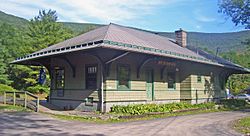
The CMRR used to run tourist trains from Phoenicia Railroad Station, Phoenicia, to Cold Brook Railroad Station. This service ended on October 31, 2016. Trains started from the old station in Phoenicia, which is also home to the Empire State Railway Museum. Passengers could board in Phoenicia or Mount Tremper.
At first, they used small track cars with trailers. Later, they rebuilt flatcars into open-air passenger cars. A small engine called a Porter 50-ton switcher pulled these cars. A old wooden caboose often rode at the back.
In 2004, a restored coach was used instead of the caboose. This allowed more people to ride and offered protection from the weather. Service was extended to Cold Brook Station in July 2008.
In May 2010, Phoenicia operations got a new engine, Alco S1 407. This engine was the main one for Phoenicia operations. A second coach was added in October 2010.
For the 2012 season, the train ran from Mt. Tremper west. On August 6, 2015, service was restored all the way to Phoenicia Station. This was after a lot of track repairs by the CMRR.
On August 4, 2016, the CMRR was allowed to keep running trains on this section until October 31, 2016. However, starting in 2017, the county chose a rail bike company to operate on this part of the line. The CMRR moved all its equipment to its own property in Phoenicia in January 2017.
Shokan Operations (Ended)
The CMRR also had a base in Shokan, New York. This was at the site of the old Ashokan Railroad Station. They had a self-powered crane and a flat car there. Shokan was also a base for track car crews. These crews maintained the parts of the line that big trains couldn't reach. The CMRR moved all its equipment from Shokan in July 2016. All tracks at Shokan were removed in 2018 for the Ashokan Rail Trail.
Other Parts of the Line
Phoenicia Station to Bridge Street
These tracks are currently leased to the Empire State Railway Museum. The CMRR hopes to share these tracks with the museum in the future.
Boiceville-Phoenicia Station
The tracks from Boiceville to Phoenicia are still in place. They are now leased to Rail Explorers, a company that offers rail-bike tours. The CMRR still stores its train equipment on its land near Phoenicia Station. This section has a big washout from Hurricane Irene in 2011. It stops trains or rail bikes from going all the way through. It is hoped that once the washout is fixed, train operations can extend to the Ashokan Rail Trail trailhead at Boiceville.
Kingston-Phoenicia Connection
The CMRR's old goal was to run tourist trains on the entire 25-mile line from Kingston to Phoenicia. However, in November 2017, the Ulster County legislature voted to remove 11.6 miles of tracks. These tracks were next to the Ashokan Reservoir. The tracks were removed in 2018. This means a full train service from Kingston to Phoenicia is no longer possible.
West of Phoenicia
The CMRR has never planned to reopen this section of the line. However, the nearby DURR has shown interest in running service to Big Indian.
Train Equipment
Locomotives (Engines)
The CMRR owns two American Locomotive Company (ALCO) RS-1 locomotives. These are engine No. 401 and No. 2361. Only 401 is currently working. In 2010, 2361 was repainted and given a new number, 400.
In May 2010, the CMRR got another engine, Alco S-1 407. This engine was important for operations out of Mt. Tremper and Phoenicia. It is now in storage.
CMRR No. 29, nicknamed "The Goat," is an old Navy locomotive. It was used as a backup engine and for work trains. It is currently for sale and stored in Phoenicia.
CMRR No. 1, called "The Duck," is another work train engine. It is operational and located in Phoenicia. The Empire State Railway Museum uses it for switching.
In 2014, the CMRR got a 1942 GE 45-tonner, numbered 42. It is in Kingston and used for work trains.
The CMRR is also helping the Empire State Railway Museum restore a steam locomotive. This is Lake Superior and Ishpeming No. 23. The restoration project has been ongoing since 2003.
Passenger Cars
The passenger cars in Kingston include five flat cars. These cars have been changed into open-air passenger cars. They have side walls, benches, and a steel roof frame for tarps.
In 2021, another 40-foot flat car (291) was also converted for passenger use. This means the CMRR has six passenger flat cars in Kingston.
The CMRR has five working coaches in Kingston. Four are former Long Island Railroad commuter coaches. The CMRR also owns Ontario Northern 832 and is fixing it up for first-class service. Another coach, ex-LIRR No. 2918, is being restored.
The CMRR also uses a caboose (No. 675) on Kingston passenger trains for the crew.
The Phoenicia passenger equipment used to include two renovated old Erie Lackawanna Railway trailers. No. 4321 became CMRR No. 701 in 2004. No. 4332 became CMRR No. 702 in October 2010. A third trailer is being restored.
Other Equipment
The CMRR also has several pieces of freight equipment. These are used for storage and work trains.
In Kingston, they have two boxcars for storage. Work train equipment includes a dump car, a flat car, a ballast hopper, and a gondola. They also have a privately owned caboose (CMRR 674).
Additionally, in Kingston, the CMRR owns a self-powered crane (CMRR 991).
In Phoenicia, storage equipment includes a box car. Work train equipment includes a dump car, a flatcar, and a transfer caboose (CMRR 697).
Phoenicia equipment also includes a privately owned steel caboose (CMRR 673). This caboose was used as a gift shop for many years.
Ashokan Rail Trail Conversion History
The decision to remove train tracks and build the Ashokan Rail Trail was a long and difficult process. It involved many discussions between people who wanted trains and those who wanted trails.
In January 2006, a newspaper announced a "Trail Plan." This plan suggested turning parts of the county-owned railroad into a recreational path. This would limit where the tourist train could go. A company called ALTA Engineering was hired to create a "rail-with-trail" plan. Their report said that combining trains and trails would be a great opportunity for the area.
On October 4, 2012, Ulster County Executive Michael P. Hein announced a plan. He wanted to remove 32 miles of rails in Ulster County and replace them with a trail. He planned to start removing rails in 2013. However, the CMRR's lease was still valid until May 31, 2016.
Three days after the 2013 budget was approved, the CMRR opened Bridge C9 in Kingston. This allowed passenger trains to cross the bridge for the first time in over 58 years.
In February 2013, the CMRR shared its own "rail-with-trail" study. The county rejected this plan without reviewing it.
In June 2013, Ulster County tried to end the CMRR's lease. The CMRR went to court and was allowed to continue its lease.
In December 2013, the New York City DEP commissioner announced support for a trail along the old rail line.
In December 2014, the Ulster County Executive said that a little over two miles of tourist train service could stay in Kingston.
In April 2015, the Ulster County Legislature created a committee. This committee was to study the entire rail corridor. They would make recommendations on whether to have rail, trail, or both.
In December 2015, the Ulster County Legislature voted to make "rail with trail" the official policy. This was for the section from Kingston to Stony Hollow. This allowed the railroad to continue operations in Kingston for 4.75 miles west. It also confirmed that rail would remain from Boiceville to Phoenicia. This decision effectively ended the big debate between rail and trail supporters.
On April 19, 2016, the County and the CMRR settled their lawsuit. The CMRR agreed to leave its yard in Kingston by May 1, 2016. They also agreed to stop operations on May 31, 2016, when their lease ended. The lawsuit cost the CMRR $700,000.
On July 18, 2016, the Ulster County Executive announced new permits for the CMRR. They could continue operating in Kingston until December 31, 2020. Service resumed on August 6, 2016.
On December 14, 2017, the Ulster County Legislature voted to remove all tracks from a large section of the line. This permanently separated the railroad line from Kingston to Phoenicia. It ended the CMRR's plans to return to the Glenford Dike and Phoenicia with full passenger service.
In July 2018, a court dismissed another claim against Ulster County. Ulster County removed 11.6 miles of track in 2018. They built a new rail-trail there. This means it is now very difficult to restore full passenger train service from Kingston to a connection with the DURR.
In late 2018, track removal began between milepost 10.01 and 21.59. This section opened as the Ashokan Rail Trail in October 2019.
Photo gallery
-
Phoenicia Station NRHP marker
See also
- Kingston, New York railroad stations




